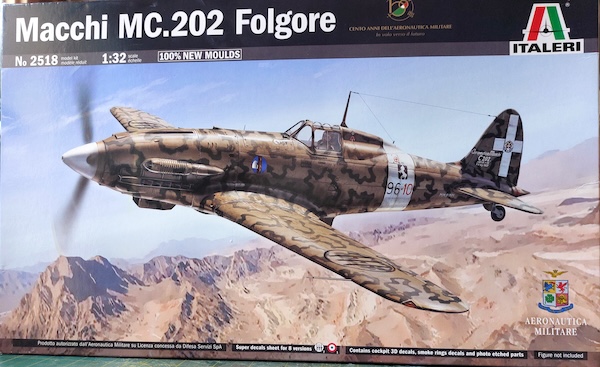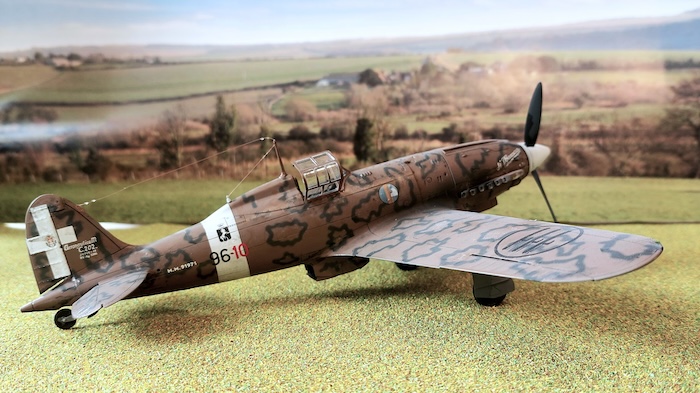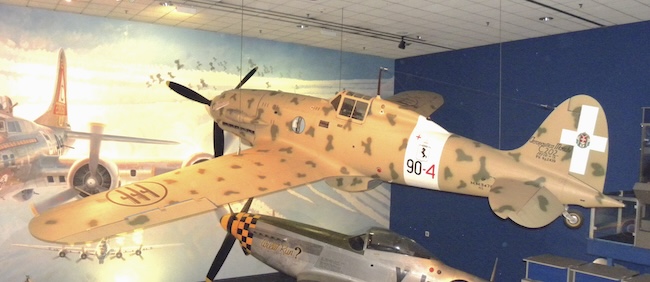
Full Review with Rob Ruscoe
Just before we get started, here’s a look at how it all turned out…

The Macchi MC.202 Folgore
The Folgore (Italian for Thunderbolt) was a WW2 Italian fighter aircraft produced by Macchi Aeronautica for the Italian Air Force. Up to this point the Italian Air Ministry had chosen to power their aircraft with indigenous radial engines and completely avoided the development of streamlined liquid-cooled designs. When Macchi Chief Designer Mario Castoldi, (hence the MC or C designation), designed the C.200 fighter, he was forced to rely on the aging Fiat A.74 radial as the power unit. Although the C.200 airframe proved to be highly manoeuvrable, the maximum speed of 315 mph meant the machine was soon considered obsolete.
In November 1939 Alfa Romeo acquired a license to produce the German DB601A engine as the RA.1000 R.C.41-1 Monsone. Castoldi now commenced work on mating the C.200 wings, landing gear, and tail unit to a new fuselage designed to accommodate the new engine.
The prototype was ready for its first flight only seven months after the start of design work and quickly proved to be an advanced aircraft for the time and indicated Italy had finally produced a fighter on a par with both Britain and Germany.
The Folgore had retained the agility of its predecessor but its top speed had improved to 375 mph. The very strong construction also enabled it to dive steeply. One bad attribute, which it also inherited from the C.200, was its lack of stall warning. The aircraft would flick violently out of a high G turn and had a tendency to enter a flat spin from which it was reluctant to recover. The other drawback was the aircraft’s weak armament – two Breda-SAFAT 12.7mm machine guns mounted in the nose and firing through the propeller disc. Although these were a similar calibre to the American Browning .5 inch weapons, the cartridge was much shorter giving a much reduced muzzle velocity and therefore less range and hitting power. In later series, a 7.7mm (.303 inch) gun was added to each wing. On most of these aircraft the extra weight of guns and ammunition was considered detrimental to performance and these were removed in the field. The Italian HF radio fitted to the aircraft was so unreliable that pilots relied more on hand signals than R/T which was a real handicap in combat.
Despite these problems, the MC.202 and its refined successor, the MC.205 Ventro, had quite a successful operational history making its combat debut against Malta before being moved to the deteriorating North African front where a number of Italian pilots achieved ‘ace’ status.
A Gruppo of Folgores was also sent to the Eastern Front at the beginning of Hitler’s offensive against Russia. They did achieve some success here before the arrival of the winter proved the unsuitability of operating the aircraft in extreme cold weather.
By the time of the Italian armistice in 1943, most remaining aircraft had been withdrawn to Italy although attrition in the defence of Sicily and Sardinia had reduced numbers to about 100 serviceable aircraft.
Two MC.202s survive to this day. M.M.9667 is on display at the Italian Air Force Museum in Vigna di Valle Airport near Bracciano and M.M. 9476 at the US National Air and Space Museum, Smithsonian, Washington DC.

(Photo: Macchi C202 Folgore fighter at Smithsonian Air & Space Museum. Courtesy Wilson 44691)